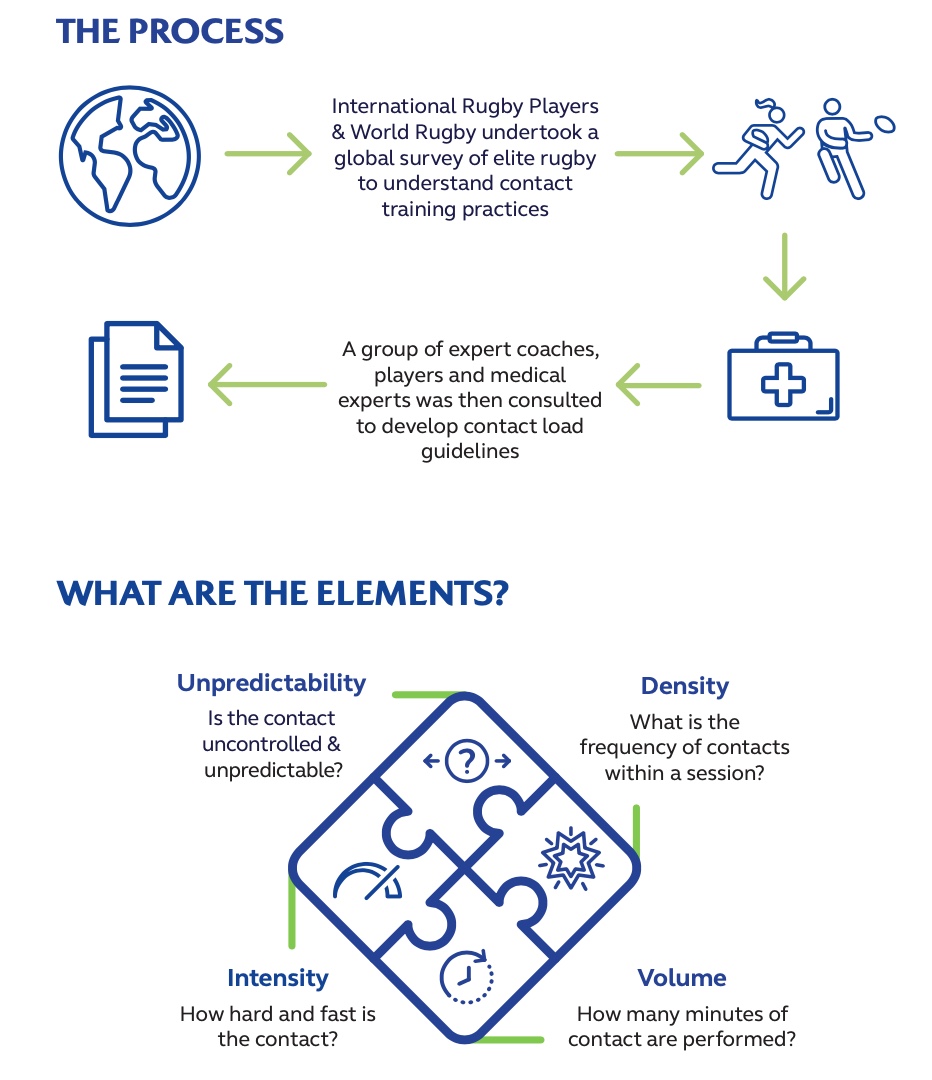
So, @WorldRugby has released guidelines for contact load during training in elite rugby. You can read the full document and a summary infographic here: world.rugby/the-game/playe… I wanted to share brief thoughts on the process & principles behind the guidelines, so here goes...
@WorldRugby First, the need. Research has found that training injury risk (in terms of incidence, or injury risk per 1000 hours) is relatively low, BUT…because training volume is so high, a large number of injuries happen in training. And full contact training has the highest risk. So the
@WorldRugby …need is created by the risk. Plus, cumulative load (including training) is clearly important. Therefore load management principles, just like you’d apply to any training programme, are crucial to reduce injury risk. That’s summarised in the first of the infographics: 

The fundamental principle is this: What is the smallest “dose” of contact that achieves the desired result? More than this adds no additional benefit but increases risk, while less fails to prepare players. This is really the crux of the issue (this is true for every sport btw)
So the process was this. First, @worldrugby is really committed to being evidence-based. Problem is, on this matter (how much training is too much?) there is no quality evidence, so it’s more about being “evidence- and expert-guided”. The evidence came from a survey of players
@WorldRugby …around the world (M & W). They provided a ‘benchmark’ for how much contact they did per week, for full contact, controlled contact & set piece training. This is important because next, an expert group of coaches, players, S&C experts, and medics, met to discuss optimal load
The survey results do not create the guidelines, but they do set up what a reasonable expectation is for what elite players currently do, what is needed & what is reasonable in terms of guidelines moving forward. The process is summarised in infographic 2 

Now for the ‘meat’. First, the expert group identified four elements that create contact risk. They’re summarised in this infographic. Key is to understand what can be controlled, & how changing any or all of these four changes risk in a session, in search of that optimal dose 

Next, of the four, the expert group identified that volume x intensity is the key to load measurement. This is common for load monitoring in sport, by the way. So that creates a tool for measurement, the contact index. 

The expert group further identified key principles for contact load. These are captured within three possible PATTERNS for load, but they all obey the following:
1. Two days of full contact load per week, three days “recovery"
2. Zero (or very low) contact load on M and F
1. Two days of full contact load per week, three days “recovery"
2. Zero (or very low) contact load on M and F

It’s within these patterns that the recommended limits per week happen. They are:
- 15 min of full contact
- 40 min of controlled contact
- 40 min of live set piece play
I would encourage anyone interested to read the full document to understand the diffs between them
- 15 min of full contact
- 40 min of controlled contact
- 40 min of live set piece play
I would encourage anyone interested to read the full document to understand the diffs between them

Then, to head of some criticisms I’ve seen, let me emphasise/clarify the following:
1. The guidelines were not created in a vacuum by lawyers. Look at the names of people involved. If you think these folk don’t understand the sport, submit your CV, because you must be incredible
1. The guidelines were not created in a vacuum by lawyers. Look at the names of people involved. If you think these folk don’t understand the sport, submit your CV, because you must be incredible

Second, nobody wants to treat the rugby community like disobedient children, so no, the idea is not to stand there with a stopwatch and issue punishment when the contact time exceeds the recommendations. These are guidelines, basically best practice recommendations from experts
Coaches may want to do more contact training. If the expert recommendations are correct, then that’s a risk they’re taking. And maybe in time, with tech, awareness & education, it will be possible to enforce, rather than advise. But people needn’t be ‘babied’ for change to happen
Then, some more musings. One ‘concern’ (for me, anyway) is that there’s a risk of creating a kind of circular logic by using player feedback to set the contact time limits. This is in a way unavoidable because there’s no data that says “X time increases injury risk by Y percent"
So for now, the only evidence is that of reported time. The expert group also knew this and tried to explore the limits from first principles rather than simply drawing the line near where it already was. The survey was crucial though, because it sets a realistic expectation for
…what is currently being done, and thus what is reasonable to ask to be done in future. I can see a future where contact load is measured much more precisely, using instrumented mouthguards (we have two big studies currently underway on this subject), so that teams can actually
…quantify head & overall contact load, and then maybe a future iteration of these guidelines advises something like “Total load per week should not exceed X impacts above Y g, and no more than 8 fully contested scrums should be performed”. Or something like that. This is a start
• • •
Missing some Tweet in this thread? You can try to
force a refresh





